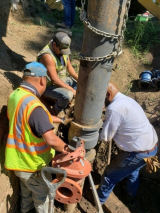National Enforcement and Compliance Initiative: Increasing Compliance with Drinking Water Standards at Community Water Systems
Problem
A community water system (CWS) is a public water system that supplies water to the same people year around. There are approximately 50,000 regulated drinking water systems in the United States. In fiscal year (FY) 2022, 43.2 percent of the nation’s CWSs violated at least one drinking water standard, which set the limits for contaminants in drinking water. In addition, 29.6 percent of CWSs had monitoring and reporting violations and 7 percent had health-based standard violations.
Goal
Begun in FY 2020, a goal of this National Enforcement and Compliance Initiative (NECI) has been to help ensure safe delivery of drinking water to communities by improving compliance with the Safe Drinking Water Act (SDWA) and fostering greater collaboration between EPA and states, tribes, and territories to create a more effective national program. An additional focus of this NECI is to increase EPA’s enforcement and compliance assurance capacity in order to work more effectively with states, tribes, and territories to meet our shared goal of addressing drinking water violations and risks to public health.
Results
During FY 2020 through FY 2023, EPA made significant progress towards meeting the drinking water NECI goals to improve drinking water compliance through inspections, enforcement, and technical assistance and to increase EPA and State inspectors’ capacity to monitor compliance. The following examples of NECI activities illustrate the EPA’s efforts to improve drinking water quality at CWSs.
-
Enforced the SDWA to help ensure communities are provided safe drinking water
EPA issued Safe Drinking Water Act orders to 185 public water systems during some highlights from new and ongoing work during FY 2023 include the following:
-
SDWA 1414 Administrative or Judicial Compliance Orders
- City of Jackson, Mississippi (Region 4)
- City of Silex, Missouri (Region 7)
-
SDWA 1431 Emergency Orders Addressing an Imminent and Substantial Endangerment
- 3M Cordova, Illinois (Region 5)
- Kickapoo Tribal System, Kansas (Region 7)
- Yellow Creek Estates Mobile Home Park, Wyoming (Region 8)
- Oasis Mobile Park, California (Region 9)
-
Inspector capacity and technical expertise
- EPA provided multiple training events to support EPA, state, tribal, and territorial drinking water programs.
- EPA hosted 37 web-based inspector trainings for EPA, state, and tribal inspectors from 2021-2023. Attendance ranged from 20 to over 370 per course.
- Since 2020, EPA provided field-based on-the-job inspector training for EPA, state, and/or tribal inspectors at 26 community water systems in Pennsylvania, Delaware, Maryland, Washington, Idaho, Virginia, Wyoming, and Massachusetts.
- EPA increased its enforcement and compliance assurance capacity in the drinking water program so that every EPA regional office now has credentialed SDWA inspectors.
- As EPA inspector numbers and capacity have increased over time, compliance monitoring/inspections and enforcement have also increased.
- In FY 2023, EPA performed offsite compliance monitoring of 254 CWSs and led or accompanied primacy programs (states, tribes, or territories that have been approved to implement and enforce the Public Water System Supervision Program) on 160 onsite inspections.
- Compliance monitoring activities increased by approximately 200% from FY 2020 to FY 2023.
- Offsite compliance monitoring increased from 83 in FY 2020 to 254 in FY 2023.
- Onsite inspections jumped from 54 in FY 2020 to 160 in FY 2023.
- Enforcement case conclusions increased from 75 in FY 2020 to 113 in FY 2023, an increase of 51%.
- EPA provided multiple training events to support EPA, state, tribal, and territorial drinking water programs.

Improved System Performance with Compliance Advisors
The Agency launched the Compliance Advisors for Sustainable Water Systems program in FY 2020 to provide effective on-the-ground technical assistance to help community water systems achieve and sustain environmental compliance. Since its inception in FY 2020, the program has provided or is currently providing technical assistance to almost 300 small drinking water systems. Assistance includes recommendations to improve system compliance, development of system operation protocols, resource evaluations, and operator training.
The program shows promising success in resolving long-standing noncompliance. For example, Compliance Advisors helped a New Mexico tribal operator who operates 10 small CWSs that had been in noncompliance and under enforcement orders for at least 10 years, resolve 96 percent of their drinking water significant deficiencies.
